OMNIS™/OPEN-DBS WITH OPENLABS™ (INCL FINE™/OPEN)
Speed and precision combined to solve multiphysics challenges
Multiphysics problems require a variety of advanced and flexible solutions. Omnis™/Open-DBS with OpenLabs™ allows engineers to solve multi-phase, -fluid, and -species challenges with both the fastest technology on the market and a freely customizable interface that can be tailored to specific applications.
The Omnis™/Open-DBS solution includes access to the trusted FINE™/Open tool.
What is OMNIS ?
Interface and Use of OMNIS
External aerodynamics for all speeds, from incompressible to supersonic
High-speed external flows can be a challenging endeavor, especially at transonic or supersonic to hypersonic speed.
With the Open solver and its density-based formulation, modeling flows that reach Mach numbers up to 20 for re-entry is a breeze.
The capabilities of the solver ensure fast and accurate flow solution, even for the most complex cases.
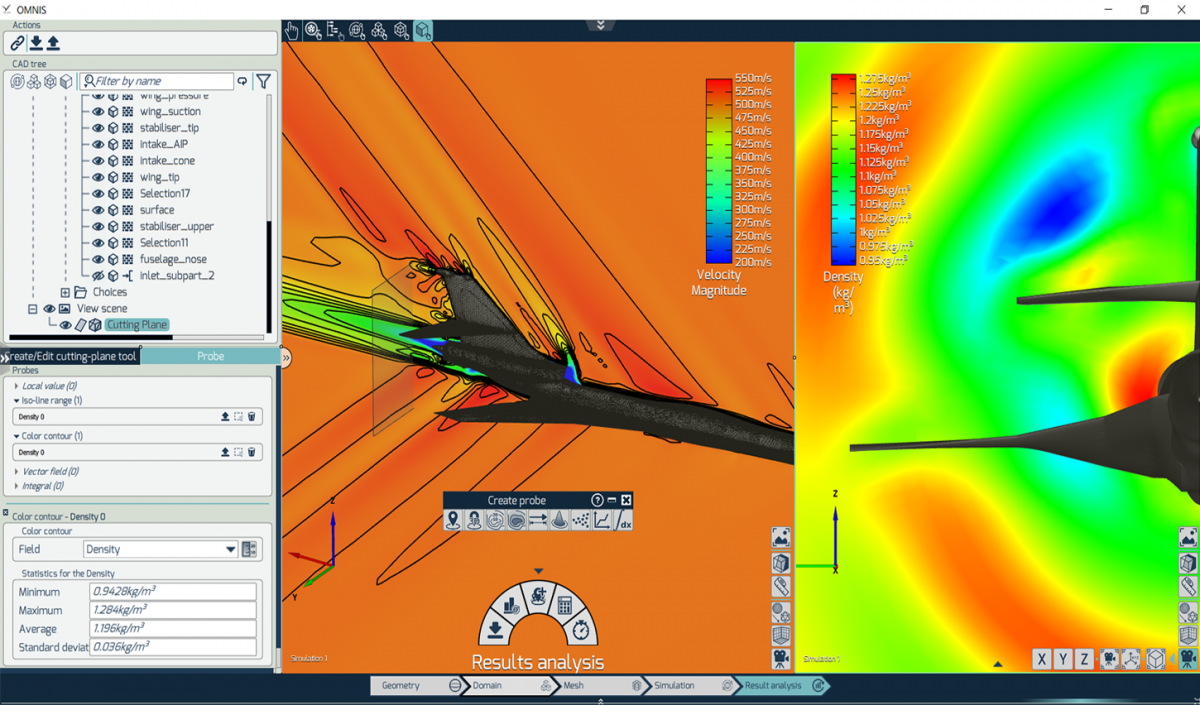
Combustion
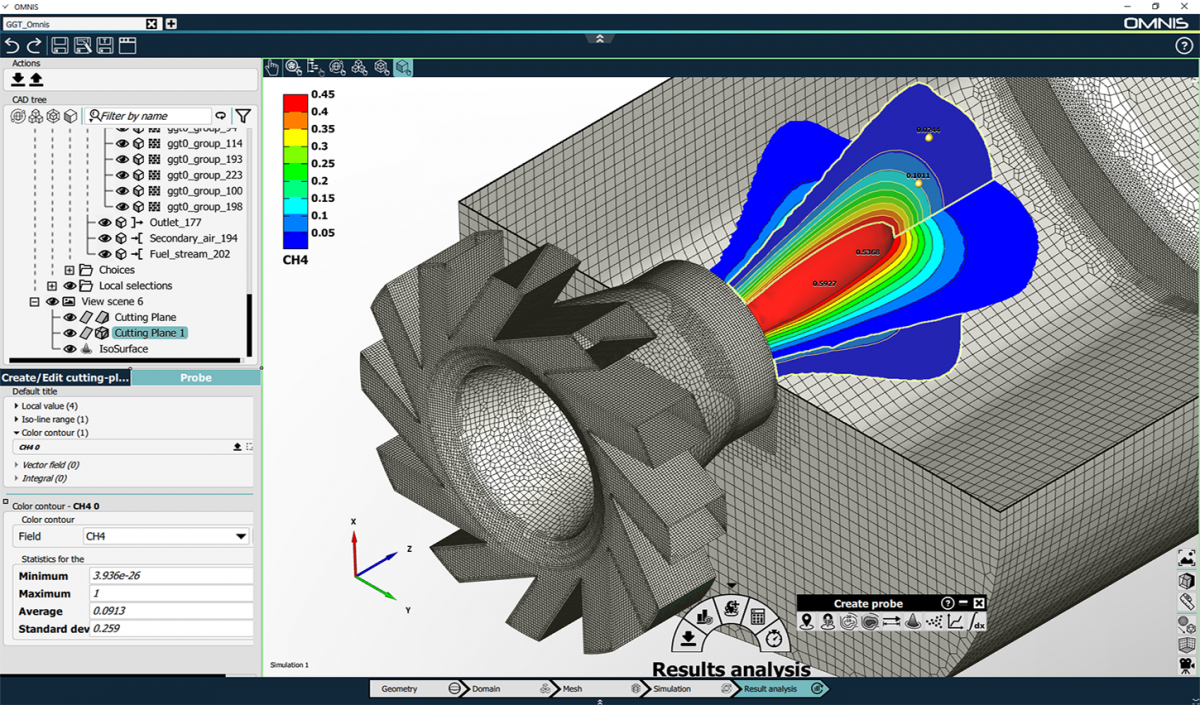
Modeling combustion applications implies handling multiple species together with complex physical and chemical reactions. Conjugate heat transfer and radiation have a large impact on the control of the temperature distribution and on combustion efficiency.
To respond to these requirements, Omnis™/Open-DBS offers several modeling strategies including the classical flamelet, the hybrid BML/flamelet method, and the Flamelet Generated Manifolds method (FGM) to analyze the range of purely non-premixed gaseous to purely premixed combustion applications.
The combustion model can be coupled with pollutant prediction, radiation, and conjugate heat transfer analysis.
Cavitation
Cavitation occurs in liquid flows when the pressure drops below the saturation pressure. It is observed in pumps, nozzles, injectors, marine propellers and underwater bodies and often causes loss in efficiency, increase of noise level, structural damages or erosion.
Our software offers three modelling approaches to analyze cavitation: the barotropic law, thermo-tables, and transport-equation modeling.
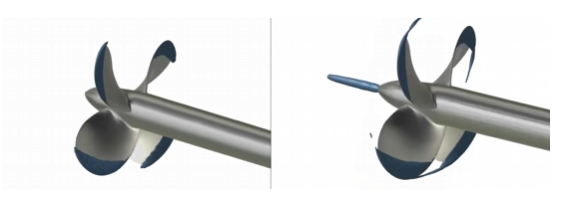
Cavitation inception: Left, no local refinement – Right, dynamic mesh adaptation
Our experience extends to cryogenic flow simulations, with advanced modeling for cavitation and phase change in thermo-sensitive fluids.
Multispecies, particle flows and sprays
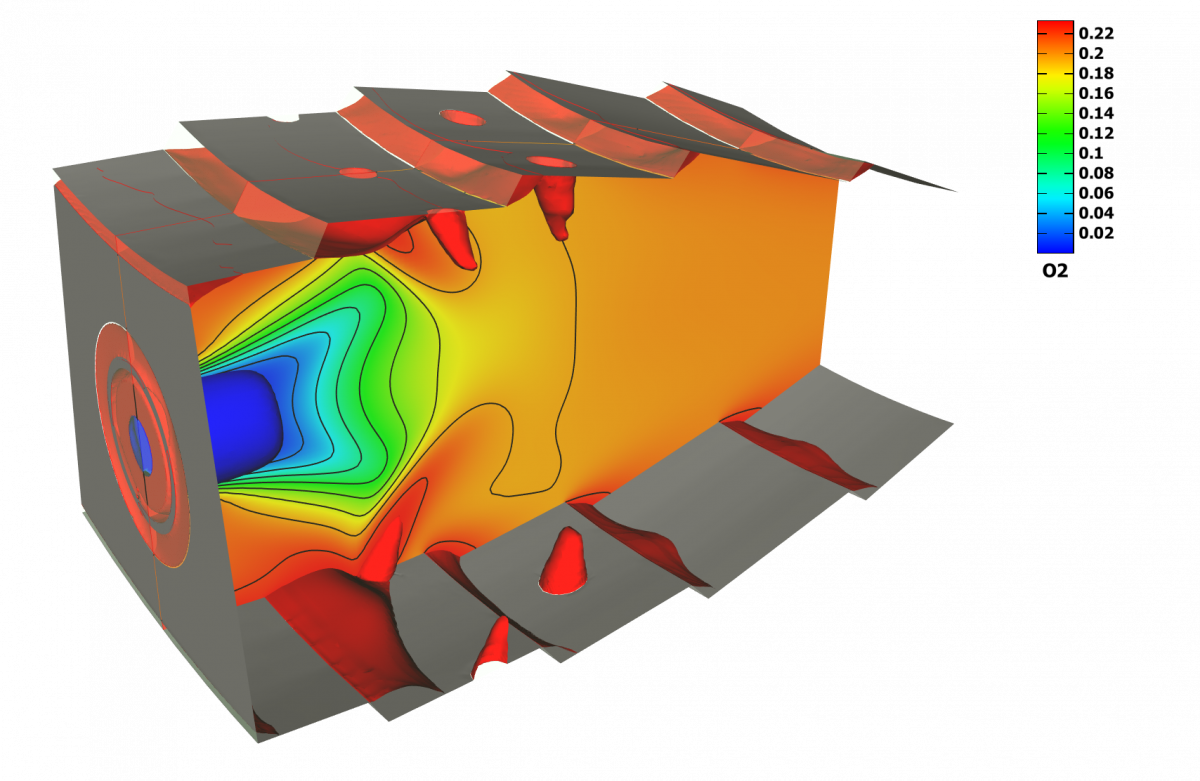
Multiphysics applications often involve two or more fluids of different nature or of different phases of the same fluid. These form mixtures and interactions occur between each.
The Open solver offers a wide range of multifluid modeling approaches whose domain of application depends on the physical properties, concentration and homogeneity of the mixture.
The thermo-tables fluid definition captures the phase change phenomena. The inert or reacting multispecies model describes the mixture of gases or liquid such as pollutant tracking. The Lagrangian particles model tracks the motion of dilute dispersed particles and their interaction with the main phase, for example sprays, particulate flows, cyclones. These models can be coupled with all other physical phenomena of the multiphysics environment.
Develop and customize freely
The OpenLabs™ module provides a simple and easy-to-learn syntax that allows the user to customize most of the routines of the solver, including adding or editing source terms, equations, controlling the initialization, the fluid properties or the boundary conditions.
These modifications are automatically compiled, which makes them execute as fast as if they were implemented in the solver source code.
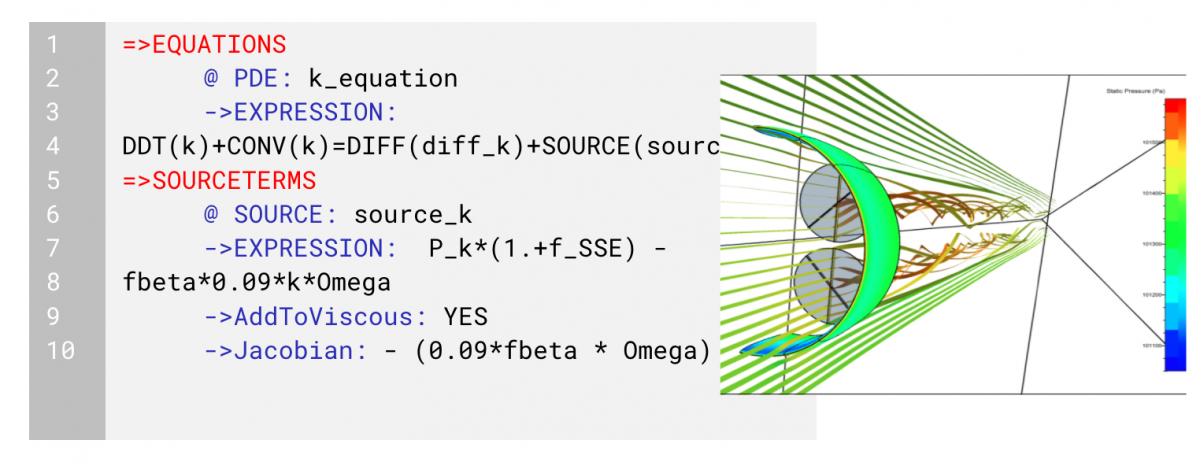
Full-engine CFD simulation
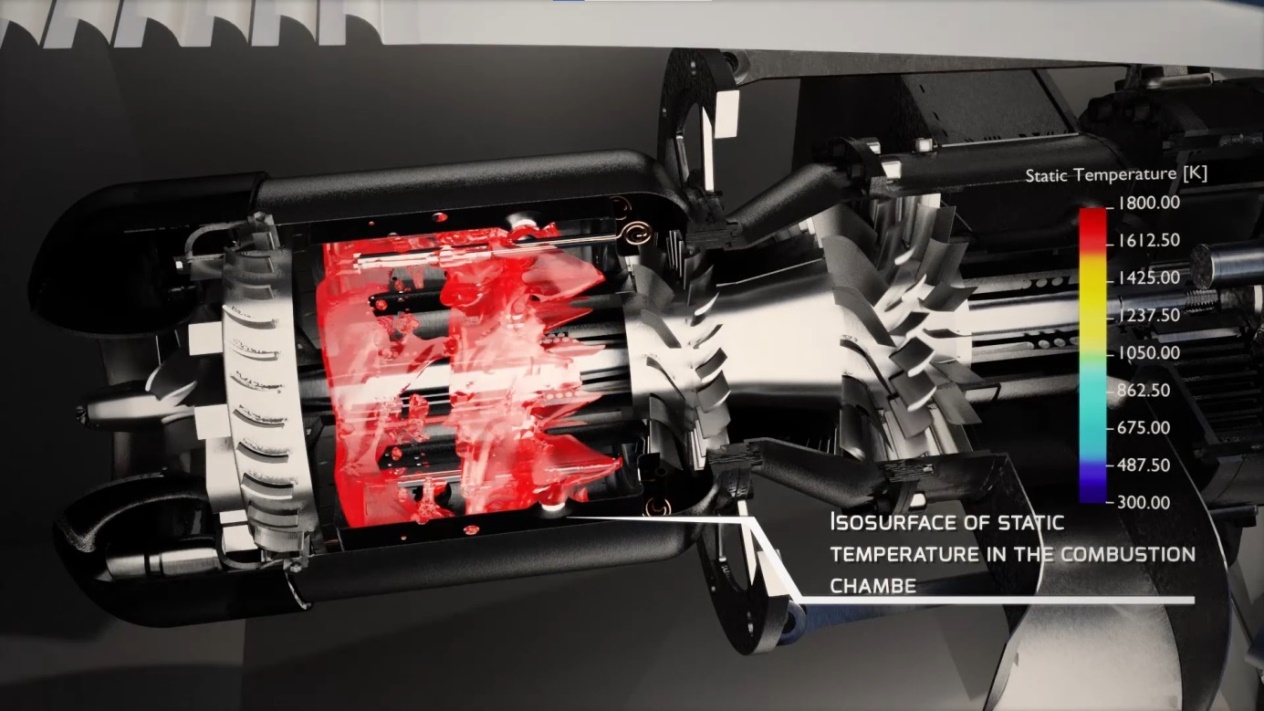
Computation of a full engine using Omnis™/Open-DBS’ NLH and combustion models
With the purpose of meeting future aircraft engine requirements in terms of low emissions, high reliability and efficiency, a novel highly efficient fully-coupled RANS-based approach has been developed, enabling the simulation of a full aero-engine within a single code.
One of the advantages of a fully coupled approach over a component-by-component approach is that the boundary conditions at the interfaces do not need to be guessed.
A Smart Interface methodology ensures a direct coupling between the different engine components, compressor- combustor-turbine, and allows the CFD models to vary between each component within the same CFD code.
For the simulation of the combustion process, the Flamelet Generated Manifold (FGM) method is applied. While the approach is superior to classical tabulated chemistry approaches and reliably captures finite-rate effects, it is also computationally inexpensive.
The Nonlinear Harmonic method is used to model the unsteady interaction between the blade rows as well as the influence of the non-homogeneities at the combustor outlet on the downstream turbine blade rows. This method is 2 to 3 orders of magnitude faster than a classical URANS simulation.
Nonlinear Harmonic for every configuration
Gain 3 orders of magnitude in solving speed for unsteady simulation.
The presence of components such as hoods, collectors, or volutes can be taken into account for a better assessment of the performance of the turbomachinery. Non-axisymmetric pressure variations can be modeled with the Nonlinear Harmonic method, with domains that can be non-periodic and meshed with mixed grids.
With the Non-Linear Harmonic method, users can solve transient behavior 100 times faster than a classic unsteady analysis, capturing phenomena like clocking, blade row interactions, tonal noise, inlet distortion…
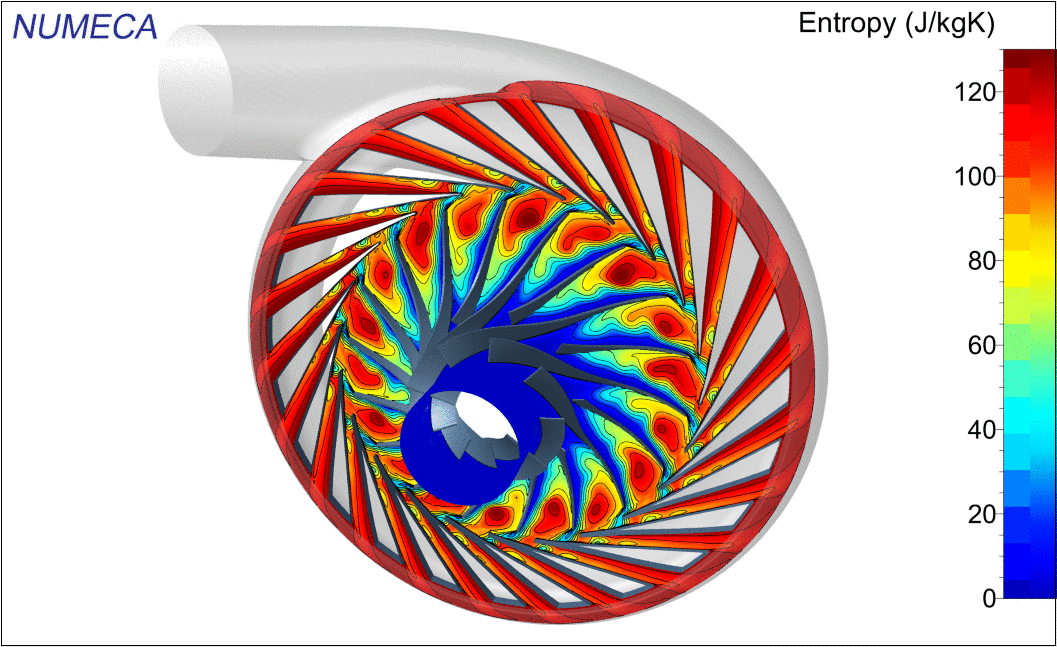
Impeller volute – Image courtesy of Liebherr
This unique technique computes the unsteady flow field by means of the Fourier decomposition of the periodic fluctuations, based on a pre-selected number of harmonics, typically associated with the blade passing frequencies and their multiples.
Fluid-Structure Interaction
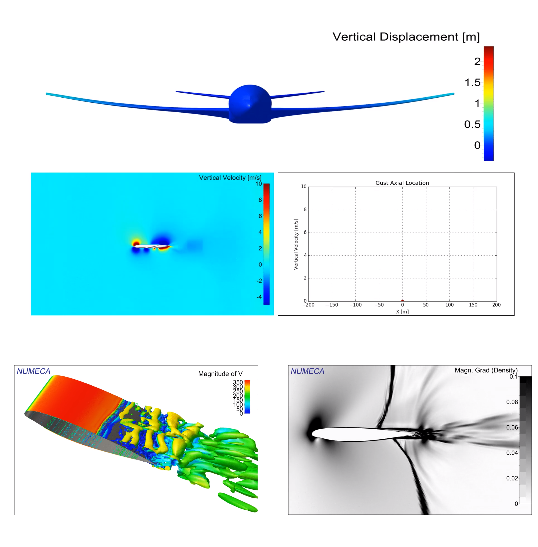
Fluid-Structure Interaction (FSI) occurs when a fluid flow deforms a structure which in return influences the flow field.
The significance of aeroelastic instabilities has increased substantially in the last few decades, particularly in the industry of aviation and turbomachinery. A continuous trend towards lightweight and cost-efficient design forces engineers to push the boundaries in the design phase with the risk of leading to vibratory stresses and, in the worst case, to vibratory failure. Cadence offers several approaches to predict fluid-structure interactions depending on:
• the direct coupling between the flow and the structural solvers,
• the use of the coupling server MpCCI, which manages the communication and the interpolation of coupling data between the fluid and structure solvers,
• or the modal approach in the flow solver that takes advantage of the harmonic solution of the NLH method and solves the modal equations, to compute the global deformation of the structure written as a composition of mode shapes, removing the necessity of interpolation between fluid and solid domains.
Turnaround time up to 20x faster than any other solution on the market
The Omnis™/Open-DBS CFD solution is optimized by scaling linearly on thousands of CPU cores, as well as on GPU.
Combined with our patented CPUBooster™ technology, a unique convergence acceleration technique, computation time is reduced even further.
The total package renders the solution up to 20 times faster than any other solution on the market.
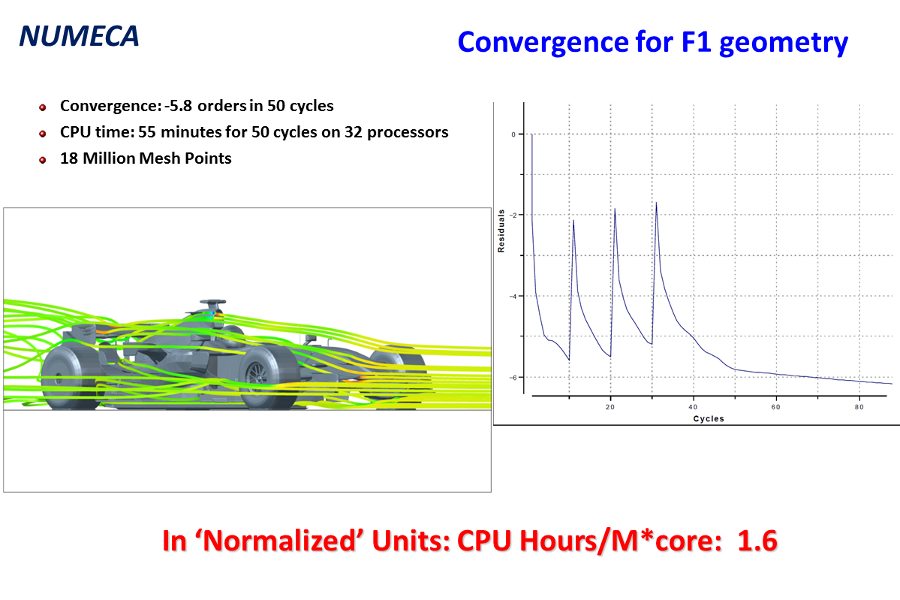
Pars Makina From All Perspectives
Eco-Friendly
In all our projects that we carry out, we strive to use renewable energy sources and equally, we prefer to use recyclable materials.
Work Ethics
We add our motivation and ethical values to our continuous development efforts and we realize our projects through an evolving design that take into account feedbacks from numerous simulation and tests.
Safety
We always place safety the first place. We prioritize worker healthin all type of field works, factory production, assembly and tests carried out in our workshop.
Social Responsibility
Through the development of high and ınnovatıve technologies, we fulfil our duty regarding the development of our country and entire world wellness.
Advanced Technology
We always provide world-class engineering and production services with our R & D and production team that follows the technological state-of-the-art in our fields of expertise.
Customer Focused
We ensure customer satisfaction by providing efficient and reliable products that emanate from our responsible and positive-thinking attitude.
Look at Us More Closely
Pars Makina develops novel technological products that results from long term fundamental R&D studies. Our intellectual property contains many recent national and international patents that increase our worldwide competitiveness. For sustained growth of our capabilities and increased market share, we continue to produce state-of-the-art solutions involving high technologies. We also strive to work closely with national and international academic institutions and leading large companies in Turkey and Europe.
Pars Makina
We provide reliable, economical, high-power and efficient innovative solutions in the fields of Transport, Defence, Aerospace, Aerospace Engineering and Clean Energy.

